Ready-Made Strategy for Lawyer Content Marketing

Establishing a robust online presence has become crucial for businesses across all industries. Law firms are no exception. Content marketing, with its ability to educate, engage, and build trust, stands as an ultimate tool for legal practices to make themselves known.
In this step-by-step guide, we will delve into content marketing for law firms. Starting a content marketing strategy focused on law firms and their practices can be challenging. In fact, it involves more than just churning out blog posts or social media updates. It requires a strategic approach that aligns with the legal industry's nuances, complies with ethical considerations, and engages potential clients authentically.
Thus, in this guide, we will address all potential nuances, offering actionable advice that encompasses everything from defining your target audience and choosing the right content topics to optimizing your content for search engines and measuring the effectiveness of your efforts.
Content marketing for law firms: definition and benefits
Traditionally, you need to define it first and learn what actual benefits it can bring to the table.
So, content marketing is, first of all, a strategy, an approach. It implies creating content that educates people, teaches them the specifics your business solves, or helps to navigate in the niche. In exchange, the business receives conversions and leads or simply increases its popularity in the niche.
For any lawyer content marketing can have different goals. Some strategies aim at attracting users, generally growing the audience. Others can opt for lead generation, where all efforts of the strategy are focused on attracting leads or users that will partner with your firm or purchase your services.
For law firms, content marketing involves producing and sharing content that resonates with the legal concerns and queries of their potential clients. By creating content that addresses legal topics in an informative and accessible manner, law firms can position themselves as educators and problem solvers, fostering meaningful connections with their audience.
Сontent marketing for lawyers can take various forms. In the next section, we will cover them in more detail. For now, let’s shift our focus from the definition of benefits. There can be numerous of them, but let’s focus on the most substantial ones.
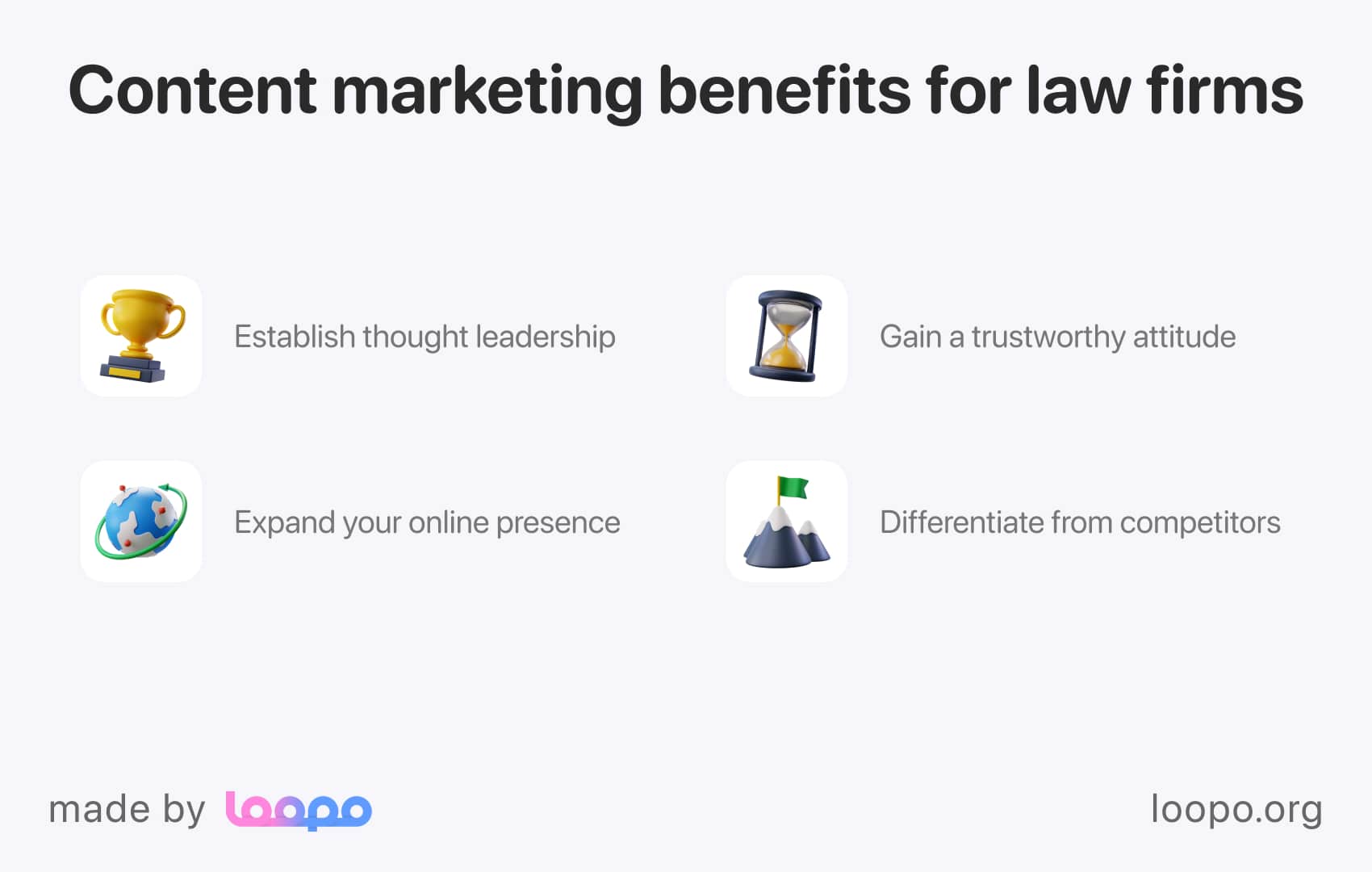
- Establish thought leadership. With high-quality content that emphasizes your legal expertise, your law firm can become a thought leader in the field. Why is this positioning important? In fact, it is the determining factor that differentiates your firm from numerous mediocre firms that are already in the market.
- Trustworthy attitude gain. When your firm consistently provides valuable information, helps users, and addresses their concerns, people are more likely to mark you as a credible venture. When individuals find reliable and relevant content on a law firm's website or social media channels, they are more likely to perceive the firm as a trustworthy authority.
- Online presence expansion. All the content your firm produces through content marketing strategy can be optimized for search engines. In return, search engines ‘reward’ websites, ranking them higher in search results. Well-optimized legal content can attract organic traffic and gradually increase the chances of potential clients discovering the firm's services.
- Differentiation from competitors. In a competitive legal field, it can be the right tool to showcase a firm's unique value proposition through useful content. By offering perspectives that stand out, a law firm can differentiate itself from competitors.
As you can see, it can help you a lot. Basically, it can gradually improve many sides of your firm, bringing value, visitors, and success metrics.
For now, let’s shift the attention to types of content, just as promised before.
Read also: 11 Types Of Marketing Strategies That Will Definitely Work For Your Company
Types of content your law firm can create
Frankly speaking, the law and legal niche are way less popular than creative agencies, IT companies, or startups. Because it is very niche, it’s important to know that not all types of content can be suitable for it. Thus, let’s look at the most promising ones.
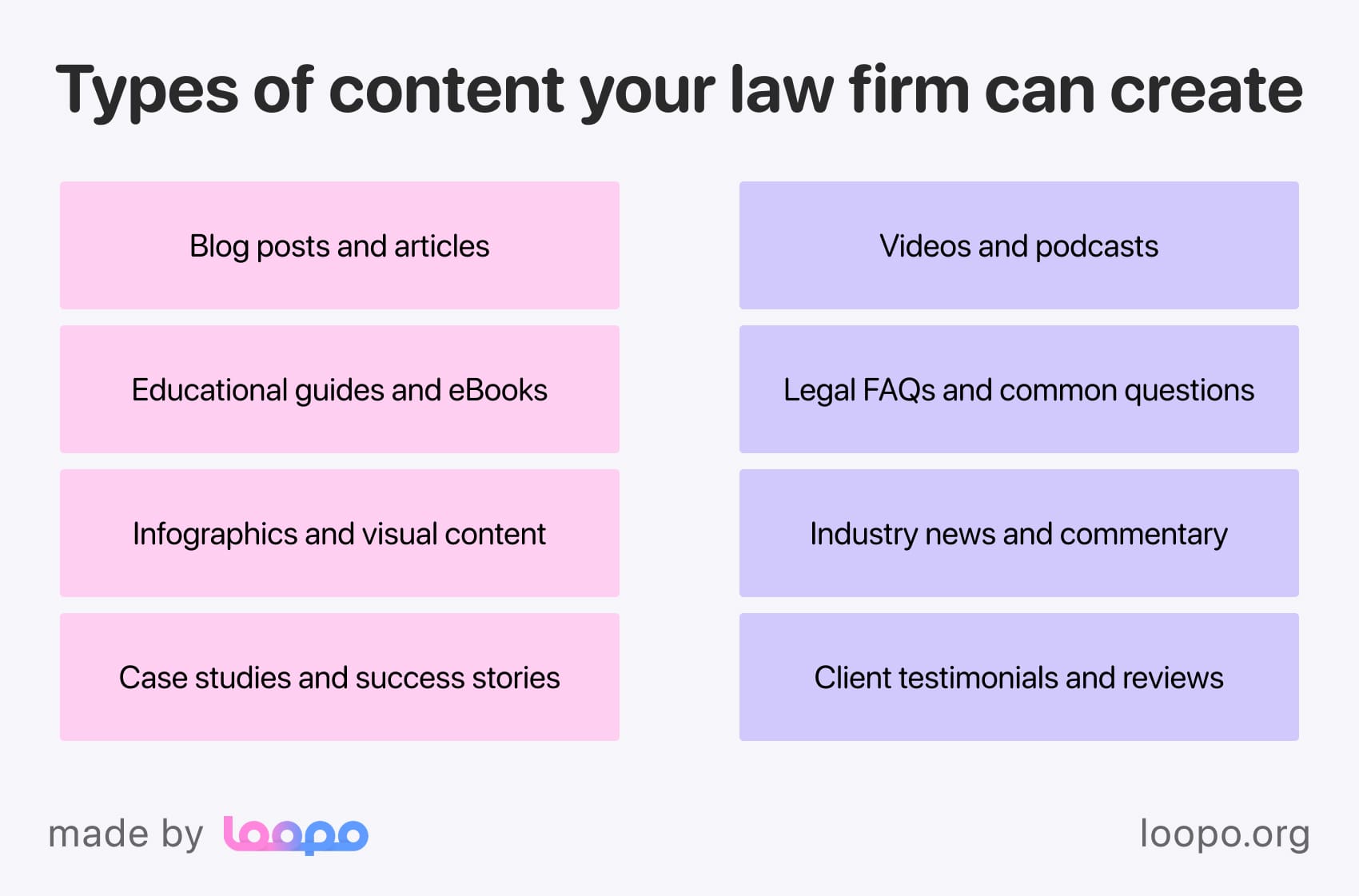
1. Blog posts and articles
The most obvious option yet one of the most viable ones. Blog posts and articles are foundational content pieces that allow your law firm to delve into legal topics in-depth. These written pieces can cover legal updates, explain complex concepts, offer insights into recent case studies, and provide general legal advice. Moreover, this type of content can improve your website's popularity in terms of search engine optimization (SEO) by targeting specific keywords and topics.
Attorney At Work is one good example of leveraging the power of the blog. On this website, you can find regularly updated articles, and tips to handle marketing for law firms, download useful content, and watch educational legal-related videos.

2. Educational guides and eBooks
Considering that the law field can be challenging for people to understand, educational guides and eBooks can be extremely trending types of content on your website. These longer-form pieces allow you to showcase your firm's expertise by providing step-by-step explanations, case studies, and practical advice. In addition, you can offer downloadable eBooks in exchange for email subscriptions. Later, they will help you build a base of potential clients that will receive your newsletters.
3. Infographics and visual content
Although not looking very serious, informative visuals and infographics can easily attract people as they convey complex information in a simple manner. Again, there are many implementations of it. You can portray intricate legal procedures, illustrate legal rights, and showcase statistics relevant to your practice areas. In addition, visuals are highly shareable. People tend to save them, share them on social media, or share them with others.
4. Case studies and success stories
This type would be extremely beneficial for your strategy’s performance. With real-life case studies, you can outline how your firm handles specific legal challenges, what approaches it chooses, and the professionalism it possesses. These narratives highlight your problem-solving abilities, showcasing the outcomes you've achieved for clients in the past.
Here is an example of a law firm that brought justice to a climate-related case and highlighted it.

5. Videos and podcasts
As visual and video content dominates the market, your law firm can benefit from it too. For instance, today, people enjoy listening to podcasts on the go, during their daily routine, or while doing sports. Simply put, podcasts last for at least an hour, which makes them perfect for discussing difficult legal topics.
One such example is the Lawyerist Podcast, where the host invites thought leaders and prominent lawyers to discuss trends and the future of the industry.

6. Legal FAQs and common questions
For lawyer content marketing is a powerful speech tool. Hence, adding frequently asked questions or FAQs is an easy but also potent technique to show your expertise. Addressing those questions and common legal concerns in your content helps potential clients find answers to their queries. Moreover, they can also be saturated with SEO elements, boosting your online visibility even more.
7. Industry news and commentary
This approach can be new to other ventures, but it is very suitable for law firms. You can comment on recent legal developments, court decisions, and changes in legislation to showcase your firm's awareness of the industry's dynamics. Moreover, this way, you can demonstrate your ability to analyze and interpret legal changes, which can attract clients seeking up-to-date advice.
Here’s an example of a law professional who takes advantage of LinkedIn. He publishes shortened versions of his articles allowing people to sense the idea of them and then naturally follow the link to the website to read the full version.

8. Client testimonials and reviews
Normally, each venture, regardless of the niche, wants to have testimonials and solid reviews. But, in content marketing for attorneys, you can turn them into content. Sharing client testimonials and reviews highlights your firm's track record and the positive experiences of past clients. These testimonials serve as social proof, building confidence among potential clients. Later on, you can enhance your articles with clients’ quotes or add them to case studies for more credibility.
7 Main steps for a content marketing strategy
A well-defined content marketing strategy is the cornerstone of a law firm's success in the digital age. You can envision it as a roadmap that includes a detailed plan of how to capture the audience’s attention and produce valuable content. Thus, we will overview several steps we consider crucial in establishing the right content marketing strategy.
1. Define your objectives
Essentially, it’s the process of realizing what your business needs and what results content marketing strategy should bring. However, objectives can vary a lot as businesses aim at different things nowadays. Hence, to simplify the task, let’s list several potential goals you might be interested in.
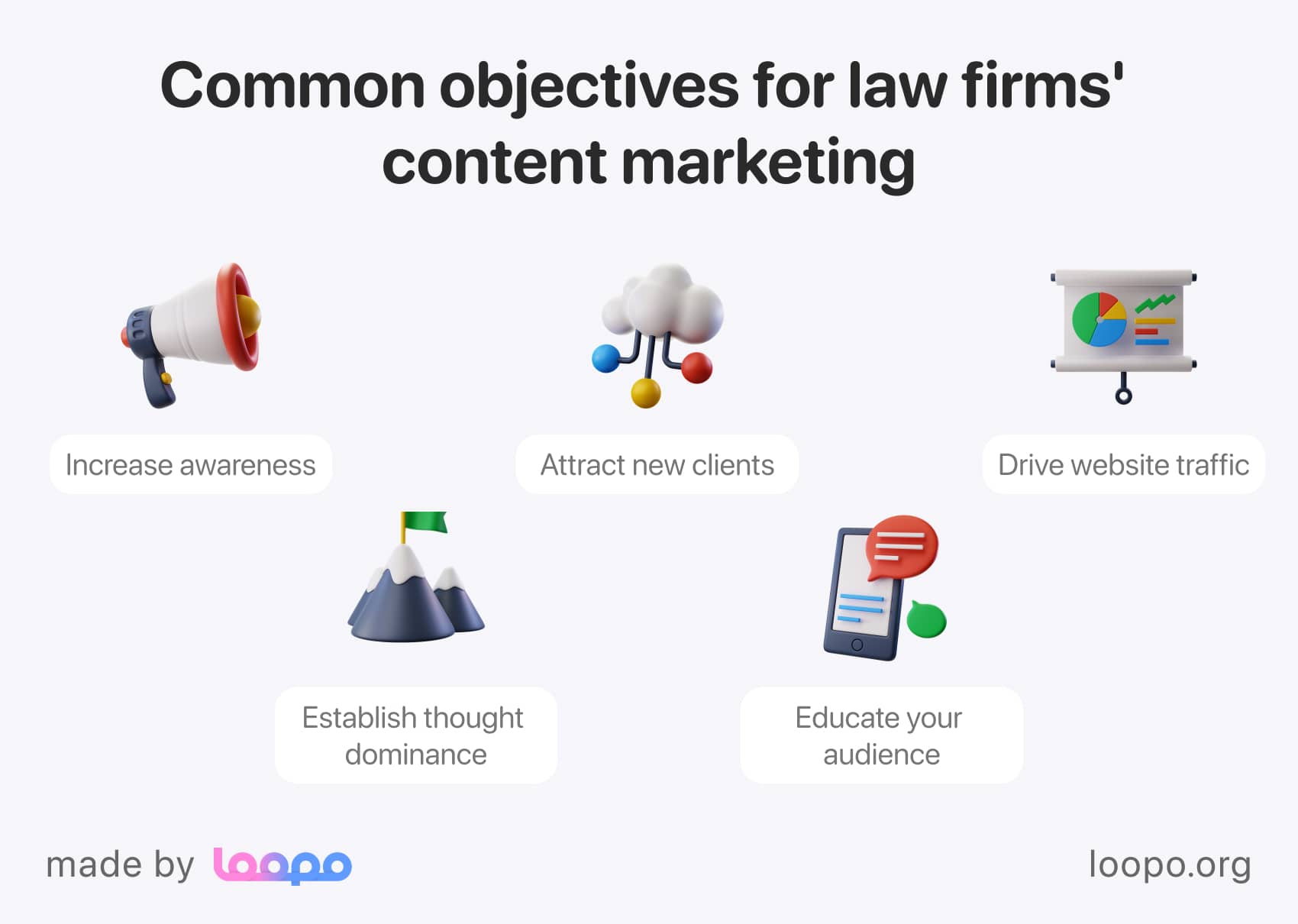
Increase awareness
If your law firm is relatively new or aiming to establish a stronger online presence, increasing brand awareness might be a primary goal. In this case, your content should focus on introducing your firm's areas of expertise, values, and unique selling points to a wider audience.
Attract new clients
Content marketing has always been a powerful lead-generation tool. If your law firm lacks clients, make sure your content addresses the legal challenges your target clients often face. With such expertise demonstration, you can position your firm as a go-to resource for potential clients seeking legal assistance.
Establish thought dominance
With thought leadership, you can dominate the market with your services, as people will refer to your publications in case there is a need. If this is your objective, your content should focus on analyzing recent news, and sensational cases, along with giving expert commentary on legal developments.
Educate your audience
Being the most popular goal so far, education is a multilayered thing. On the one hand, it helps to nurture new people, build trust, and educate them. On the other hand, it still contains some promotional aspects, such as case studies, practical examples from your firm’s cases, and so on. Moreover, with the educational intent, you can cover a wide range of legal topics, enhancing them with explanations and actionable advice to support your audience in understanding complex legal matters.
Drive website traffic
This is another popular goal your law firm might have. Apparently, traffic is important as some percentage of the people who visit your website can easily turn into potential clients. Thus, to increase the traffic and appear in search results more frequently, dive deeper into search engine optimization, or SEO for short.
This approach emphasizes content optimization. To do so, it uses relevant keywords, links and other elements to enhance publications, which, in turn, attract organic traffic.
2. Understand your target audience
Knowing your audience is always crucial, especially for law firms. They provide very niched services and, thus, must be acknowledged of their clients’ needs, problems, or interests.
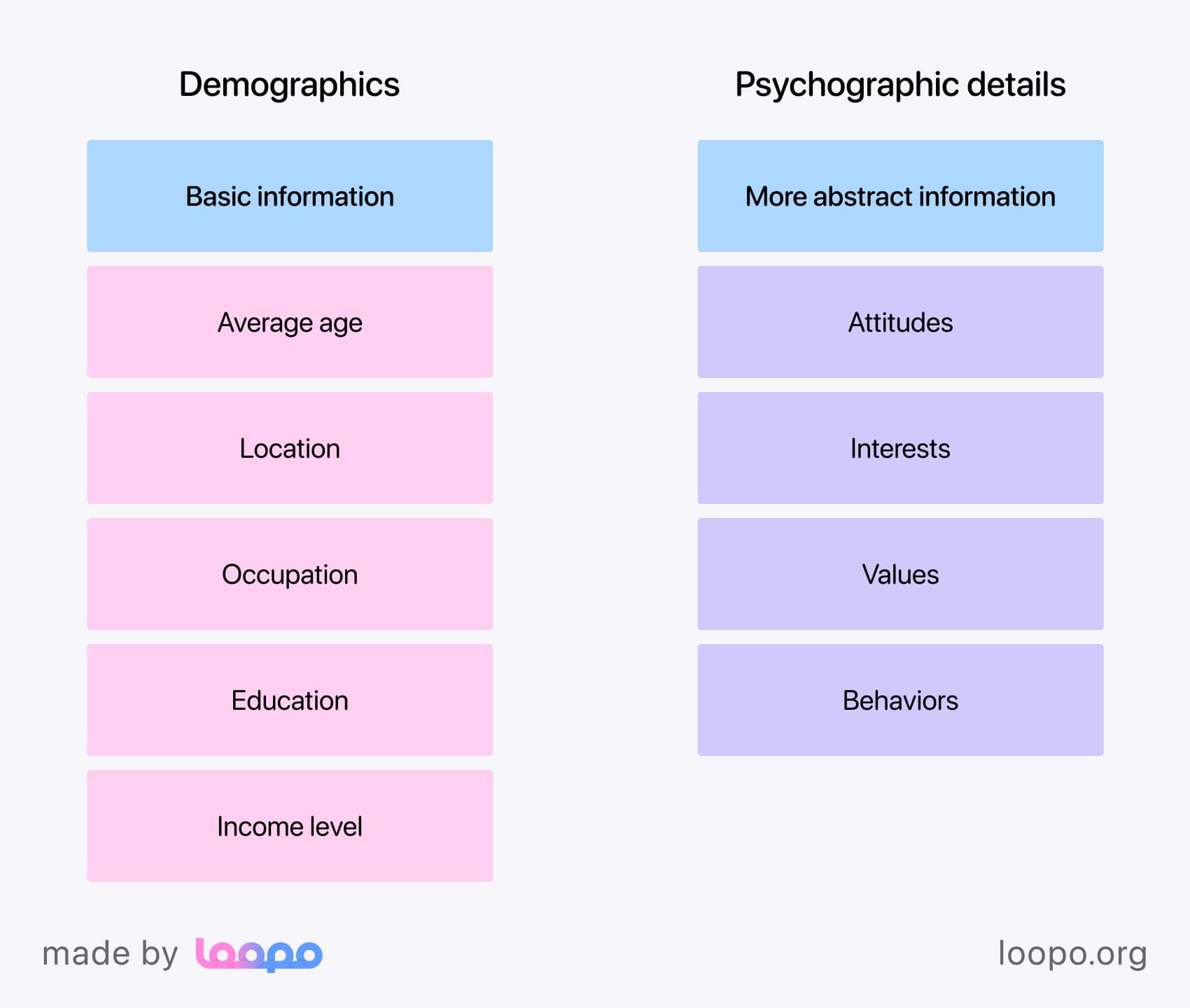
So, to understand your target audience, start by analyzing demographics and psychographics. First, draw a line between them.
- Demographics aim to figure out basic information about clients. Thus, it usually includes average age, location, occupation, education, and income level.
- Psychographic details are more focused on the attitudes, interests, values, and behaviors of your target audience. Understanding psychographics allows you to create content that resonates emotionally and aligns with your audience's beliefs.
In fact, understanding both of these factors can help you a lot in making moderate marketing decisions.
Next, understanding the audience also includes figuring out what their needs are in your field. Needless to say, the legal and law industry is niched, yet it has many different aspects within it. So, to make marketing content for lawyers successful, you should address all legal needs your customers have.
Lastly, make sure you keep up with trending questions and common pain points of people. Knowing them, you can adjust your content to address them, providing solutions, advice, and information that address these issues, positioning your firm as a valuable resource.
To better understand your target audience, consider creating detailed buyer personas. They are imaginable representations of your ideal clients based on real data and market research. It helps humanize your audience and guides your content creation process. A buyer persona typically includes:
- Name and background details;
- Demographic information;
- Job role and responsibilities;
- Goals and challenges;
- Pain points and objections;
- Content preferences and channels;
- Decision-making factors etc.
3. Develop a content calendar
Keeping notes of your content plan is another crucial success factor. However, notes may not be enough if your plan grows big and you use different channels and content types. In this regard, you will need a content calendar, and luckily, Loopo has got your back!
First, let’s outline what you will need from it. Ideally, you should use a tool that allows you to plan publications ahead, set deadlines, assign tags to sort them and edit the content. Loopo can do all of the above and even more.

Essentially, Loopo comprises a content calendar with a task management functionality making your planning process easy. With the content calendar it offers, you can create a well-structured plan to ensure a consistent flow of content and stay organized.
4. Create high-quality content
In fact, it’s easier said than done. However, top-quality content is a must, and the majority of your efforts should be aligned with it. In this regard, there are eight essential tips we would recommend to adhere to.
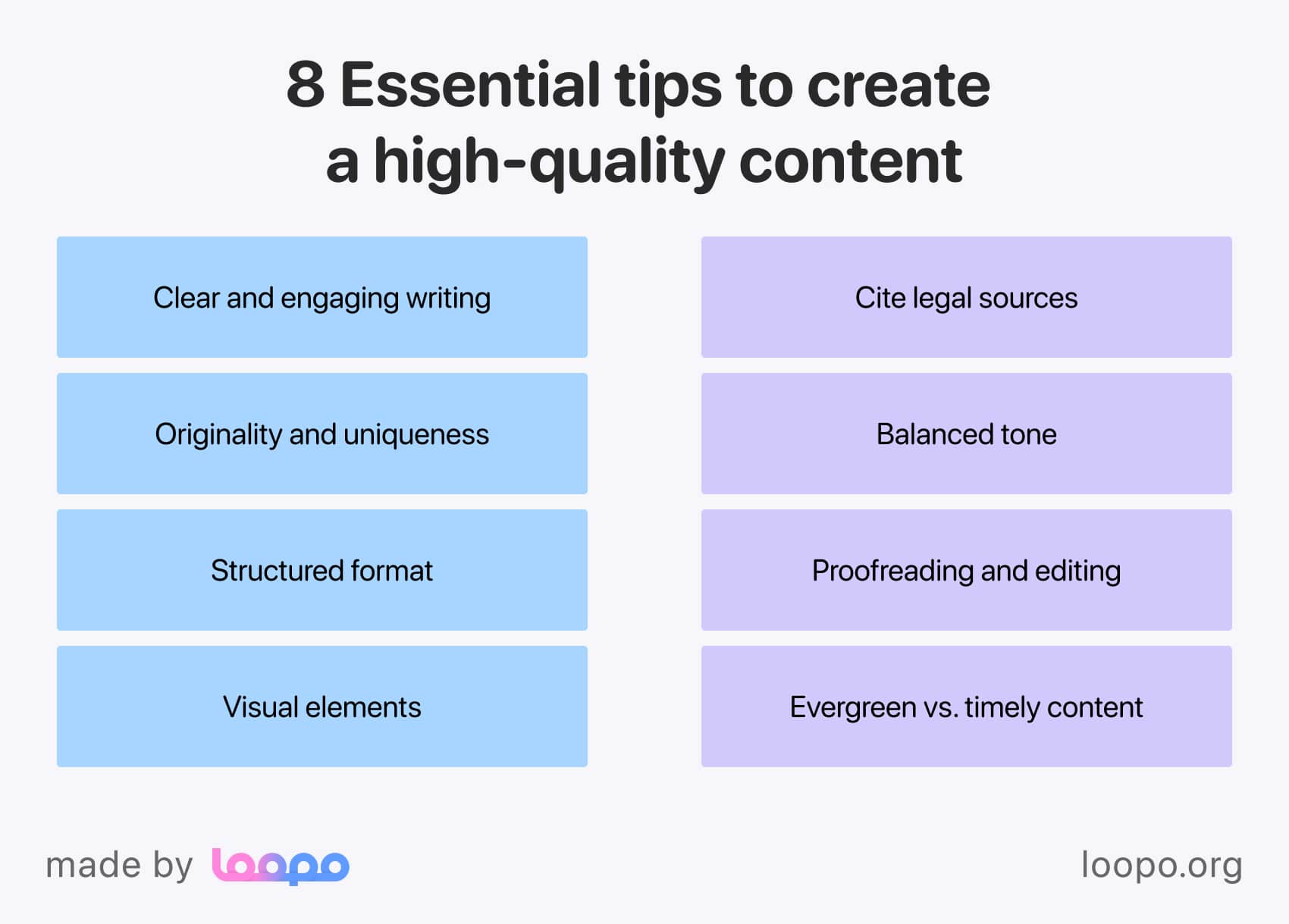
Clear and engaging writing
Text is the core of your content. Thus, regarding the niche affiliation, the manner of your writing has to be both concise and engaging. Use language that your target audience can easily understand, avoiding excessive legal jargon that might confuse readers.
Originality and uniqueness
Needless to say how uniqueness is important in writing. Despite the fact that many legal concepts are quite common, you should strive to provide a unique perspective when writing about them. This way, you will set your content apart from what's already available online.
Structured format
Everyone had problems finding information on websites where information is laid out clunky. Thus, choose a suitable format that is easy to read. For example, never neglect all types of headings, lists, or bullet points to break up the content and enhance readability.
Visual elements
In your niche, information can be difficult to understand. Fortunately, you can ease it with visual elements. You can try adding explanatory diagrams and infographics to make those complex concepts more understandable.
Cite legal sources
Referring to reputable sources in your publications can greatly improve your content’s effectiveness. Moreover, in the legal field, people need to see not only your take on the information but also references and sources of the information you are covering.
Balanced tone
Maintaining professionalism is important, but you also need to balance it with empathy and simple storytelling to engage readers. Such incorporation can make your publications more relevant, friendly, and, more importantly, understandable.
Proofreading and editing
Any high-quality content you will ever encounter is always error-free. Hence, make sure your grammar is perfect and the text doesn’t contain spelling mistakes and typos.
Evergreen vs. timely content
These are the two types of content you need to find a balance between. For more understanding, evergreen content is the type that is always relevant, even after a long period of time.
Timely content, on the other hand, is the one that outlines trending information that is relevant for a short period of time.
Mixing both ensures that you know about both the latest developments and classic topics that are inherent to the legal niche.
5. Optimize content for SEO
Search engine optimization can be a good booster of content marketing for law firms. Essentially, SEO utilizes trending words people use, and specialists enhance publications with them. They also add meta descriptions and links so that search engines treat publications better and show them to users once they search for something similar. If you are planning to incorporate search engine optimization, here are the most crucial aspects you should consider.
- Keyword research. SEO specialists effectively use services like Surferseo, SEMrush, or Ahrefs to do it. These services simplify the task of keyword research, allowing specialists to monitor their difficulty, volume, and overall popularity. Later, these words are incorporated into the text to boost its visibility online.
- Long-tail keywords. Alongside your main keywords, long-tail ones are keywords that look like specific phrases or search queries. Traditionally, they are longer and more detailed but are more difficult to implement.
- Meta title and description. Each piece of content requires an attention-grabbing meta title and description. They will appear in search results and provide a snapshot of what your content offers. To create an effective title and description, enhance them with main keywords and do not exceed word/character limits.
- URL structure. URL is basically a link to the website or page on the web. So, in SEO practice, URLs are customizable and have to be concise and descriptive. Normally, they should include your main keyword and a clear description of the content.
- Internal and external links. Adding links throughout your publications can greatly raise your credibility and improve users' experience. In this regard, internal links stand for those that lead to other relevant pages of yours, while external usually display other resources on the Internet.
- Image optimization. As you can see, everything is optimizable. Images are no exception. If your content includes images, you can add alt text to optimize them. This improves the accessibility of your content and also helps search engines understand what the image is about. Furthermore, images shouldn’t exceed 100-150 KB to let pages load significantly faster.
Overall, SEO optimization is a continuous process with many aspects. However, it can be relatively easier for law firms, as, again, the content such firms produce is very niched with lower competition.
6. Engage with your audience
Your users are not static, and they need your attention. Unlike others, law and legal fields are not easy for a person without a background in it. Thus, your users will regularly have questions and concerns. Accordingly, they require care from your side, which you must provide. So how can you do it?
- Respond to their activity. People are always active on social media, they leave comments, debate, or show their perception of their information. Accordingly, always engage with them as an expert and respond promptly. You can start by answering their questions and elaborate on their concerns.
- Encourage activity. Responses from the previous point are not enough. In addition to them, you must foster conversations. In social media, for example, ask thought-provoking questions that stimulate responses. In blogs, add a possibility to contact you so people can find out more about the services or information you provide. This approach can spark discussions that deepen engagement and provide valuable insights.
- Learn what they think. No matter the positive or negative feedback, remember to always respond to it. People always criticize because there’s nothing perfect in our world. However, their feedback is an opportunity for you to improve. You can address feedback publicly or privately and, within your responses, demonstrate your willingness to listen and improve based on your audience's input.
- Ask for input. What’s interesting for you may not be interesting to users. Hence, involve your audience in content creation. You can create polls asking about their opinion on your publications. Alternatively, ask them about what they would like to learn more and tailor your content accordingly.
- Try going offline. As a law firm owner, an online presence is not enough to establish enough credibility. Thus, you can organize webinars and create live Q&A sessions or lectures based on your case studies. They provide people with an opportunity to ask real-time questions and meet you in person.
7. Measure and analyze
Now, to the final, yet one of the most important steps. We covered a lot so far, but the right measurement and analysis is the step that brings sense into all the previous steps. In other words, you can try different approaches, but it’s analysis and measurement that will help you see what works and what doesn’t.
Traditionally, it’s a vast topic. So, here are the major game-changing things you can do.
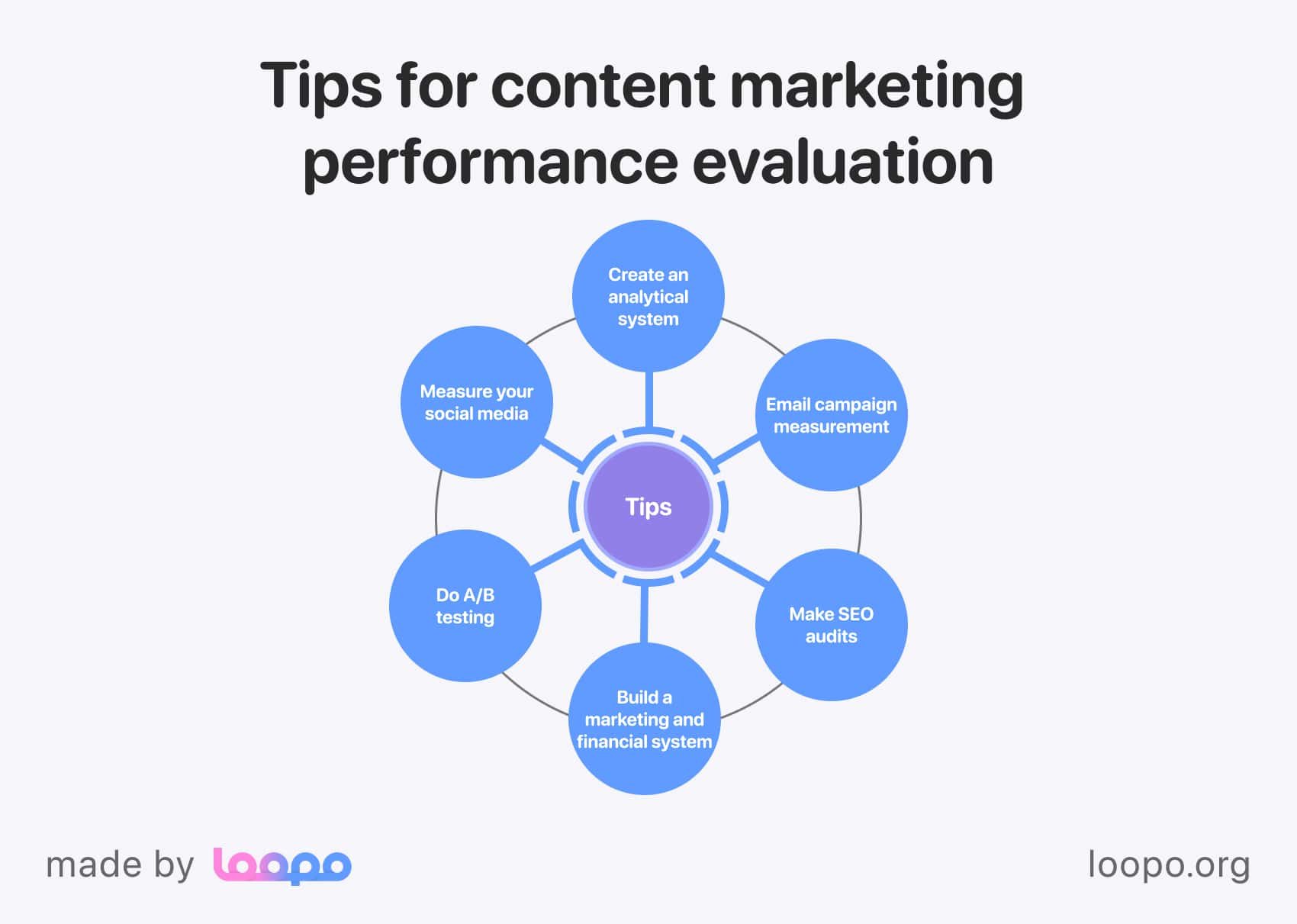
Analyze your website. Consider it as a bridge between you and your clients. In this regard, analyze its performance and see what needs improvements. Google Analytics can be of utmost help in tracking website traffic. It allows you not only to see the traffic but also to dive into user behavior and engagement metrics. With its help, you can see what content is more popular, approximate the time users spend on your site, and detect pages with high bounce rates. Apparently, Google Analytics covers a lot, and at the start, you won’t need to use other tools.
Measure your social media. As the most potent channel, activity on social media can be challenging to measure. Fortunately, each platform, be it LinkedIn, Instagram, or any other, provides a lot of insights. They allow you to see your page visits, number of shares and likes, etc. Alternatively, you can create a custom report in HubSpot, Hootsuit, and similar analytics monitoring systems.
Create an analytical system. Depending on your goal, you can set up a system of metrics for all marketing channels and track which one performs better. Accordingly, you will be able to effectively delegate tasks and address various pain points faster. For example, with conversion tracking, you can compare the number of users who fill out contact forms and schedule consultations with those who leave the site before taking the desired action.
Email campaign measurement. If you opt for email marketing as your primary lead generator, you can track related metrics as well. For example, huge email marketing accelerators and platforms like MailChimp allow you to see different rates. For example, they include open rates, click-through rates, and conversion rates. Then, it’s simply a matter of analysis to see which types of content resonate most with your subscribers.
Make SEO audits. SEO is essential to any publication, and if you implemented it, you made the right choice. During SEO audits, you can monitor the rankings of your content on results pages. SEO audit also helps to analyze all the links that lead in and out of your site. Moreover, thanks to meticulous analysis during SEO audits, you can reveal problematic aspects of the site, broken links, pages, and unoptimized elements.
Build a marketing and financial system. In simple words, marketing’s primary goal is to bring benefits to business. Accordingly, when applying a content marketing strategy, you need to account for the specific needs of the law firm. To make it effective, consider the financial aspect of the firm, which will help you set future plans. Moreover, the more information about the company you have, the better you will know which key metrics to track and what results to aim for.
Do A/B testing. This approach is all about experimenting. According to its logic, you need to create two or more versions of your content and see which one works better. For example, you can change elements, like pictures, headings, or ways you present information. Then, you compare two options and see which is more fruitful in terms of your desire.
Make it regular
Content needs regular care. Thus, you cannot analyze it once and pretend it will yield results forever. Thus, make sure you measure and analyze it regularly. Normally, companies and businesses set up different frames depending on their desire, content type, and so on.
In this regard, you can do it in your comfortable way. Create a schedule and review your content on a weekly or monthly basis. At the very least, you can do it quarterly.
Adjust based on real data
With a regular analysis, you can open the door to make data-driven adjustments. This way, you won’t make blind choices. Instead, you will be able to see patterns, address them, and make your content marketing strategy even more potent. Simply put, if certain types of content are consistently performing well, consider producing more of that content. If certain topics aren't resonating, reevaluate their relevance or explore new angles.
Content production cost: law firm edition
Prices are volatile and vary depending on your location, budget, and efforts. However, there are a few thresholds you can learn and project the approximate price of your future content marketing strategy. Here is a table outlining parts of content marketing law firms can use, along with minimum and maximum prices.
| Content marketing aspect | Minimum monthly cost | Maximum monthly cost | Description |
| Content strategy
| $1,000
| $3,000
| Creating a comprehensive plan outlining goals, target audience, content topics, and distribution channels.
|
| Content creation
| $400
| $2,000
| Cost for content creation (e.g., blog posts, articles, infographics, videos) depends on complexity and length.
|
| Social media management
| $300
| $1,500
| Cost for managing social media accounts, including content creation, scheduling, and community engagement.
|
| Email marketing
| $100
| $500
| Cost for designing and sending newsletters, promotional emails, and automated email campaigns.
|
| Search engine optimization
| $300
| $2,000
| Cost for optimizing law firm website content, building backlinks, and improving search engine rankings.
|
| Graphic design
| $50
| $200
| Cost for creating visuals like custom images, infographics, banners, and other graphics for content marketing.
|
| Video production
| $500
| $5,000
| Cost for creating high-quality promotional or explainer videos, including scripting, shooting, and editing.
|
| Content distribution
| $100
| $500
| Cost for promoting content through paid ads, influencer partnerships, or content syndication platforms.
|
| Analytics & reporting
| $100
| $500
| Cost for tracking performance metrics and generating reports to measure the effectiveness of content marketing.
|
| Total monthly cost
| $2,850
| $15,200
| Range of total monthly costs for content marketing (sum of all aspects). |
Regardless of what you choose, it is always important to remember that you can do it practically for free or at least with minimal investment. When businesses start, owners and CEOs take the majority of the work on themselves. Thus, you can start with little to no budget dedicated solely to marketing and still create a solid strategy. After all, not all starting businesses are ready to spend a percentage of investments or income on marketing.
Bottom line
By the end of this piece, you may wonder whether you need this content marketing strategy for your law firm after all. In fact, you do need it. Marketing is one of the very few pillars, thanks to which modern businesses survive.
If you think about it, for any law firm content marketing is extremely versatile, as it covers audience, metrics, content, analysis, planning, and a lot more. Moreover, it can come in many forms, and you are free to choose which is the most suitable for your law firm.
In this article, we covered a lot of marketing aspects. Feel free to check other postings of ours in the blog to discover even more. As marketers, we may not be very proficient in law and legal fields, but we are sure that this article is a great door for you to learn about our marketing world.





